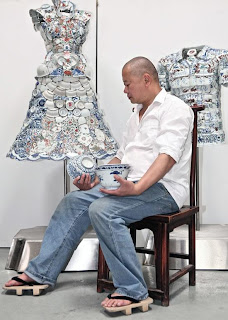_______________________________________________________
LI XIAOFENG
'Made in China' series
What do I think of his work?
I'm a big fan. I love any work that you can see the time and effort engrained into. I prefer the work he's done that includes a figure. What Xiaofeng is trying to say with his use of antique china I feel is enhanced by the use of a body within the clothing. I get more of a sense of history from these sculptures, even if they are a little more obvious. I think if the clothing was made more obviously antique then it would work better. I'm very inspired by his use of material though. I've been thinking about what makes clothing fine art - by changing the person wearing the clothes, the environment around them, the materials they're made from etc. I think changing materials is probably the most direct way to step away from fashion into fine art.
Is it considered fine art?
The pieces are created from broken porcelain that he sources from ancient archeological digs. He shapes, polishes, then drills holes into each piece to string them together with silver wire. He classes the process as 'rearranging landscapes'. The pieces are usually in the form of clothing, traditional Chinese dresses and jackets, as well as military uniforms. Although each piece would have to be meticulously planned and constructed - a process which some class as a definition of craft -, the history and intent behind each piece, as well as each sculptures uniqueness, stops it from being a mundane activity.
Does it count as textiles?
They are technically wearable, but would take a lot of reconstruction and help to enter the clothing. It's similar to armour, and in the same realm as 'clothing' like Franc Fernandez's 2010 meat dress, worn by Lady Gaga.
He was commissioned by the clothing brand Lacoste in 2010 to design polo shirts that reflected his sculptural style. For this, he photographed the china and assembled it digitally. Although not as impactful as the original sculptures, it creates a garment that has a lot more history and meaning than most.
I plan to do a similar thing in my own experimentation. By using a scale of pieces - starting off with the highly abstract and toning it down in steps until you're left with a piece of clothing adept for the high street. I can then ask a varied audience which of the pieces they consider fine art, and when it slips into merely being a piece of clothing.
“For the limited edition printed polo, he chose blue and white shards with lotus and children designs from the Kangxi Period (1662 – 1772 AD) of the Qing Dynasty (1644 – 1911 AD). The lotus grows from mud underwater to emerge as a flower, symbolising purity and rebirth. Images of babies represent fertility, as during that period the high infant mortality rate meant that people decorated ceramics with babies hoping they would be blessed with children.” (Official press via Lacoste)
____________________________________________________
HECTOR HERNANDEZ
Using a similar theme to Xiaofeng is Hernandez. By placing irregular materials on a body to cover the models modesty, it turns them into clothing in the viewers eyes. This sheet of metal, that we recognise as harsh, sharp and jagged, has been sculpted in such a way to suggest fluidity. I think a lot of breaching the gap between clothing and art is by falsifying materials and disguising their original characteristics. Bart Hess uses this a lot, and creates video that shows how the use of material affects movement and behaviour.
The photo has a childlike nature with the relaxed pose, widely placed feet and the hiding of the face. Similar to animals, young children would find this calming if stressed because they can no longer see what's upsetting them.





No comments:
Post a Comment